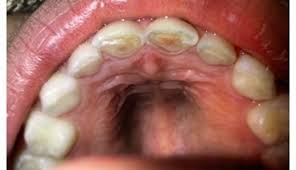
We see a lot of patients in our practice that exhibit visible signs of clenching and/or grinding. While most people know what grinding (bruxing) is and the damage it can do, many people are unaware of the destruction a clenching habit can do.
People that do not clench, their teeth never touch unless they are eating. Notice if your teeth are together during the day… that is clenching. It doesn’t have to feel like you are bearing down on your teeth, but the simple act of teeth touching causes damage.
In the natural anatomy of a tooth, as the enamel coating approaches the root of the tooth, it gets thinner. When a person clenches, the pressure, over time bends and flexes the tooth causing the thinner enamel to pop off at the gumline. Where the enamel has been lost, the softer root surface exhibits notching at the gumline. These notches are known as abfractions. Abfractions are not cavities, but rather lesions that can become sensitive, especially to cold temperatures. An abfraction does not have to be very deep into the root to be close to the nerve.
Clenching can also cause tooth wear on your front and back teeth. When the enamel is worn away on a back tooth, the high cusps of enamel become flattened and cupped out. The tooth will have round lesions that look like dots on dice. These pockmarks are areas where tooth on tooth contact over time has worn away the hard enamel leaving the softer middle layer of tooth exposed. Lower front teeth shorten in height and upper front teeth thin at an angle, both exposing the softer, yellowish middle layer of tooth structure. The middle layer of the tooth wears faster than the hard enamel, leaving the brittle, glassy enamel unsupported. It then splinters, and chips off leaving the front teeth jagged and paper thin.
